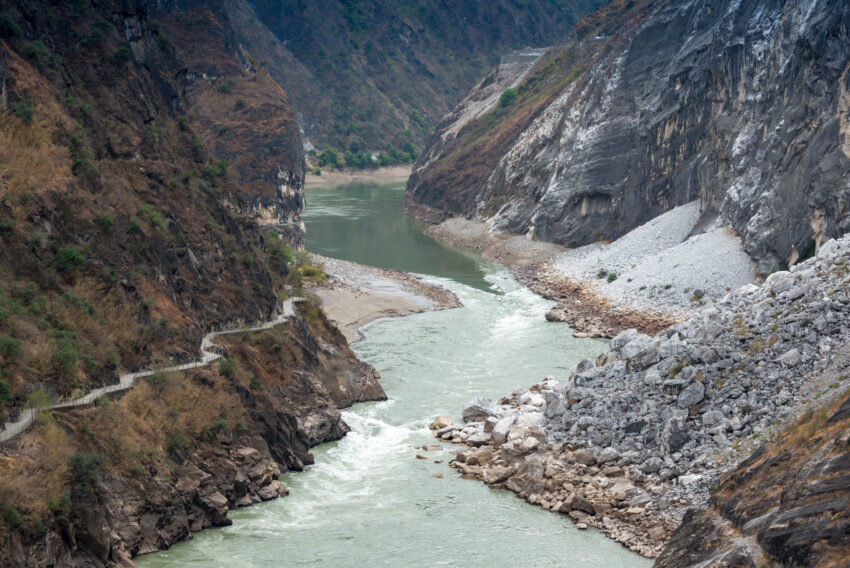
The Three Parallel Gorges, Yunnan, China, is a wild and remote region, standing close to the Myanmar (Burnese) border, in China’s subtropical southwest. Here, in this isolated corner of China, three rivers run in deep gorges: the Salween, Mekong, and Yangtze Rivers. Wherever you look, you will be admiring the most spectacular mountain scenery. Definitely no picture or video can do this natural wonder any justice.
Besides, UNESCO describes the Three Parallel Gorges of Yunnan Protected Areas, China, as “maybe the most biologically diverse temperate ecosystem the world”.

Highlights
The Three Parallel Rivers
Mountains and jungles of bright green colors surround these mighty rivers, as they roaring along their journey. Their waters are brown-colored, as a result of the sediment washed down from the Tibetan Plateau. From up there, they snake their way south and east before diving down to the Yunnan province.
From north to south, the gorges run in parallel for about 200 miles (320 km).
The Salween River
The Salween, or Nu Jiang, makes its way to the west, and it’s 1,900 miles (3,058 km) long. It passes through a series of gorges going into Myanmar, before finally draining into the Bay of Bengal.

The Yangtze River
The Yangtze, or Chang Jiang, is 3,900 miles long (6,276 km) runs to the southeast. It surges through Laos, Thailand, Cambodia and Vietnam, until it reaches the South China Sea.

The Mekong River
The Mekong, or Lancang Jiang, goes between the aforementioned rivers. This river is 2,700 miles long (4,345 km), which makes it the 3rd longest river in the world. It crosses central Chine and then enters the East China Sea, close to Shanghai.

The Gorges’ biodiversity
This region is all about ancient forests and glaciated peaks, as well as forests, glaciers, lakes and meadows. To truly appreciate the range of scenery in the area, you need to set out on foot. This way, you will also get the opportunity to explore the remarkable biodiversity. Around 6,000 species of plants fill the area, and a rich variety of wildlife awaits. Above all, red pandas, snow leopards, black bears, and exotic birds can be found in the Three Parallel Gorges.

How to get there
As you would expect in such a remote region, access is not easy. Besides, trekkers mostly focus on the Salween Gorge, reached via the town of Fugong, a 12-hour bus ride from the nearest airport, at Dali (DLU), to the south. From Fugong, buses continue north along bone-shaking roads to the settlements of Gongshan and Bingzhonglou. Starting points for treks into the best of the gorge scenery.
When to go
The climate varies a great deal from one gorge to the next, and from north to south. As a general rule, any time between October and March is good for lower altitude treks. Additionally, areas below around 3,000 ft (915m) are warm all year. Also, the main trekking area around the northern part of the Salween Gorge is slightly colder but still fine for trekking in the winter months at lower altitudes. The period from April through September is often wet.

How long
It takes around 9 hours to visit this wonderful park
Opening and Closing Hours
Everyday: 8:30 a. m. – 6:00 p. m.
Planning
National Park tickets in China are never cheap. Set aside ¥300 for a single park. It is necessary to book in advance.

Inside Information
There is some risk of altitude sickness. Anyone heading into this region should acclimatize well to the altitude before setting out. Most travelers can easily do this along the Yunnan tourist trail. Kunming is at 2000 m (nearly 7000 feet) and all the other towns on that route are higher.

More generally, the area is remote, mountainous and not much touristed; be certain your health, skills, and equipment are adequate for the conditions. Consider taking an organized tour or hiring a guide.
The entire park is geologically active. Landslides can happen during and after heavy rain. Avoid being on the road in such weather.
History
In the 1980s, an expert at the United Nations found a marvelous natural scene on a satellite map of the Northern Hemisphere. The Three Parallel Rivers of Yunnan Protected Areas are a UNESCO World Natural Heritages since 2003.
Websites
Other nearby attractions
Besides the Three Parallel Gorges, China offers a far more accessible encounter with a similar scenery. Visiting Tiger Leaping Gorge, near Lijiang on the Yangtze, is surely another unforgettable experience. Besides, this is a primary affluent of the Yangtze River.

If you loved this article or found it useful, don’t forget to share it with your adventurous and travel-hacking friends! If you want more posts like this, follow us on Youtube, Instagram, Pinterest, Twitter or Facebook and subscribe to our newsletter!

